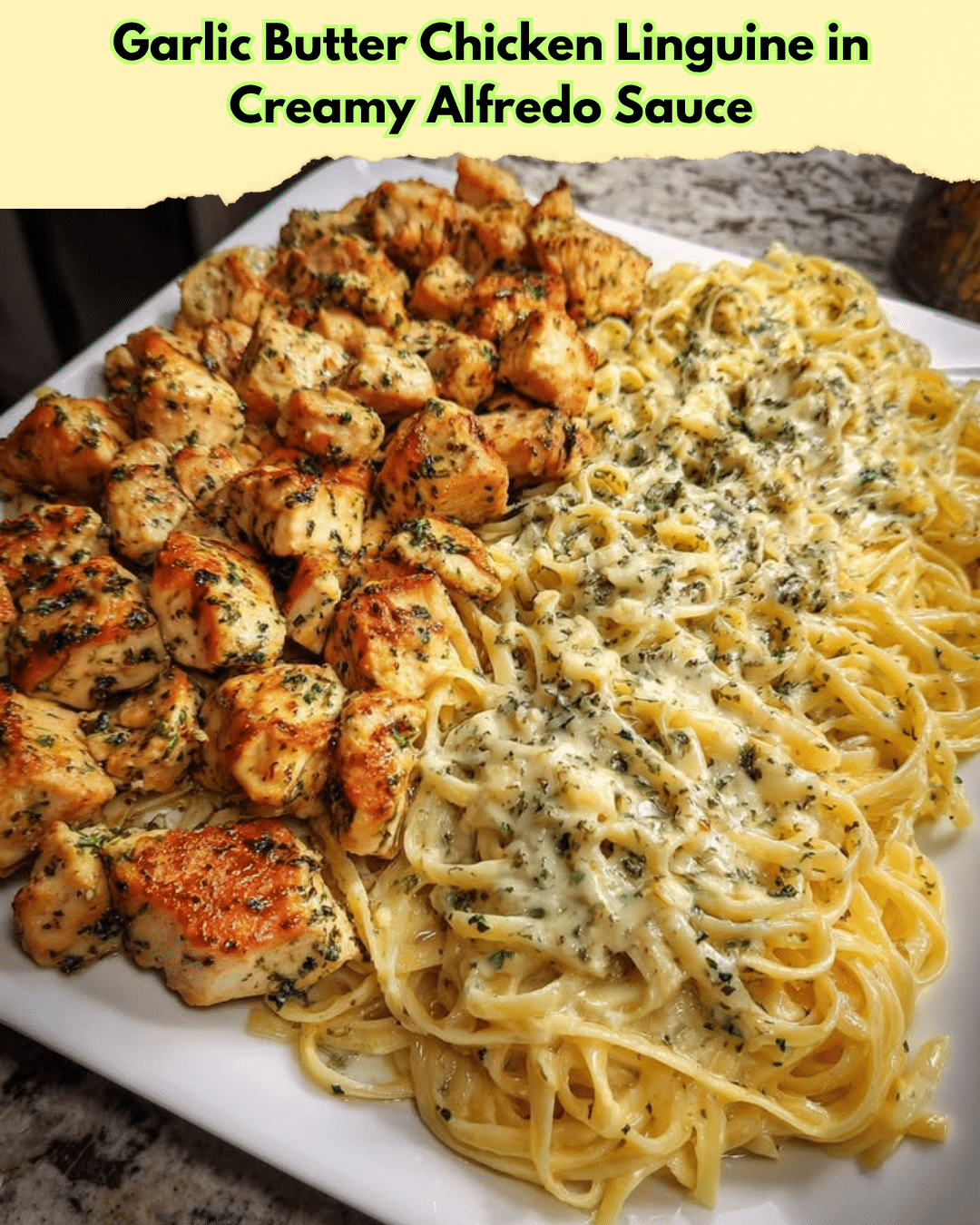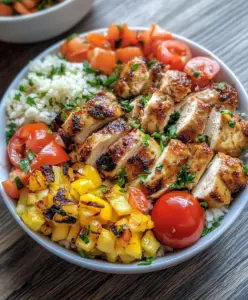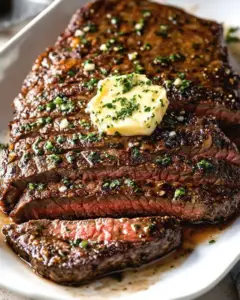Garlic Butter Chicken Linguine in Creamy Alfredo Sauce: A Flavor Explosion for Your Taste Buds
Indulge in the delectable Garlic Butter Chicken Linguine in Creamy Alfredo Sauce, a dish that brings a burst of flavor and comfort to your dining table. This recipe combines the richness of garlic-butter-infused chicken with the smooth, creamy alfredo sauce, making it a favorite among pasta lovers. Perfect for a family dinner or a cozy night in, this pasta dish enhances the comforting tastes of the Italian tradition while offering a satisfying blend of textures and aromas.
Golden chicken pieces, drenched in a savory garlic butter, provide the perfect meat element to this linguine dish. As you bite into the tender chicken, the alfredo sauce envelops your taste buds with its creamy consistency, leaving a lasting impression. For those in search of a meal that’s both indulgent and sophisticated, this recipe is designed to meet your culinary cravings. So, gather your ingredients and prepare to be transported to a world of culinary delight with this Garlic Butter Chicken Linguine in Creamy Alfredo Sauce.
Quick Recipe Highlights
- Flavor Profile: A harmonious blend of rich, creamy alfredo sauce with savory garlic butter and tender chicken.
- Texture: Creamy sauce meets the silky, tender pasta and succulent, juicy chicken in every bite.
- Aroma: Inviting and tantalizing, the aroma of garlic butter paired with creamy alfredo fills your kitchen.
- Visual Appeal: Golden-brown chicken atop a bed of glistening linguine with flecks of parsley for freshness.
- Skill Level Needed: A moderate level suitable for cooking enthusiasts prepared to balance flavors and textures.
- Special Equipment: A large skillet for chicken and sauce, and a pasta pot for perfectly cooked linguine.
Recipe Overview
- Difficulty Level: This Garlic Butter Chicken Linguine in Creamy Alfredo Sauce recipe is of medium difficulty, ensuring both beginners and seasoned cooks can create a restaurant-quality dish at home.
- Category: This dish falls under main courses and is perfect for family meals or intimate dinners.
- Cuisine: Italian-inspired, this recipe takes classic alfredo pasta to new heights with an added layer of garlic butter chicken.
- Cost: With accessible ingredients like chicken, pasta, cream, and cheese, this recipe is budget-friendly, costing approximately $15 to $20.
- Season: Ideal for fall and winter, when warm, comforting meals are most appreciated.
- Occasion: Perfect for casual family dinners, date nights, or even special gatherings where hearty dishes are celebrated.
Why You’ll Love This Recipe
The Garlic Butter Chicken Linguine exudes an irresistible taste and texture, combining delectable hints of garlic and rich alfredo. The dish’s creamy texture enhances the smoothness of the linguine, and the succulent chicken elevates the meal, providing versatility with each bite. The savory outcome is satisfying and deeply fulfilling for pasta aficionados and comfort food advocates alike.
When it comes to convenience, this recipe shines. With straightforward preparation and minimal kitchen overload, you’ll have a gourmet-quality meal on the table in no time. Whether you’re balancing weeknight chaos or savoring a weekend culinary adventure, this recipe fits seamlessly into any schedule without compromising on flavor or quality.
Nutritionally, the balance of protein from the chicken, carbohydrates from the pasta, and essential fats from the alfredo enrich the meal, offering genuine sustenance. By incorporating wholesome ingredients and an array of natural spices, this dish gratifies the palate while respecting macronutrient balance.
This recipe’s intrinsic social appeal involves its shared enjoyment, as a garlic butter chicken linguine brings people together over good food and great conversation. You’ll find that serving this meal not only satisfies hunger but creates memories deserving of repeat culinary bets.
Finally, the cost-effectiveness and accessibility of essential ingredients ensure that anyone can recreate this masterpiece without straining the wallet. Enjoy the luxury of a home-cooked delicacy, accessible anytime the craving strikes, without the added inconvenience of sourcing rare ingredients or costly provisions.
Historical Background and Cultural Significance
The origins of linguine can be traced back to the Liguria region of Italy, where pasta dishes became a staple due to their versatility and pairing with abundant fresh ingredients. Traditionally, linguine is paired with delicate seafood sauces, emphasizing its thin and delicate nature compared to other pasta forms.
Garlic butter, ever-present in European culinary traditions, marries beautifully with pasta, introducing a new cultural dynamism when combined with alfredo sauce. Alfredo itself, a creation from chef Alfredo di Lelio in the early 1900s, has evolved from its simple beginnings of butter and parmesan over fettuccine.
Over time, the adaptation of Chicken Alfredo has found a home in robust, hearty meals designed to appeal to North American tastes. The inclusion of chicken was practical, providing a source of protein easily accessible and adaptable to many palates.
Regional variations have introduced impactful diversifications, from spicing with chili flakes in southern Italy to incorporating boiled eggs as a garnish in Romanian-inspired versions. Whatever the variation, this dish maintains a flexible charm, effortlessly transforming alongside specific regional practices and ingredient availability.
Ingredient Deep Dive
Chicken is a fundamental protein that has shared its presence across countless cultural dining tables for centuries. In this recipe, chicken breasts offer a tender canvas for garlic butter infusion, enhancing every piece’s savory notes. Nutritionally, chicken provides lean protein essential for muscle repair and growth.
Garlic, revered for its pungent aroma and flavor, has historic roots in ancient medicine, being a staple in Italian and Mediterranean cuisines. It not only bolsters flavor but offers numerous health benefits, including cardiovascular improvement and immune system strengthening.
Heavy cream is the backbone of a luxurious alfredo sauce, pairing with parmesan to form a velvety sauce. When selecting cream, option for high-fat varieties for the richest sauce. Proper storage ensures longevity in the fridge, maintaining freshness for several days after opening.
Pasta, specifically linguine, brings a sophisticated elegance to this dish, its shape perfect for retaining sauce without becoming too overwhelming. When shopping for pasta, opt for brands that use quality wheat for the truest Italian experience.
Common Mistakes to Avoid
- Overcooking chicken: Avoid a rubbery texture by not overcooking. Ensure a light browning without losing moisture.
- Undercooked pasta: Linguine should be al dente to offer the desired texture, so check periodically for doneness.
- Skipping pasta water: Save some cooking water to perfect your sauce consistency.
- Using pre-grated cheese: Hand-grate parmesan for smoother melting and true flavor integration.
- Rushed sauce: Allow the sauce to thicken gradually, ensuring all components incorporate evenly.
- Under-seasoning: Salt and pepper adjustments between stages ensure a balanced and flavorful final dish.
- One-pot dreams: Separate the sauce from the pasta until plating to secure respective textures.
- Minimal resting time: Rest chicken shortly post-cooking for juiciness and flavor enhancement.
Essential Techniques
Properly browning the chicken is key, as it locks in juices while caramelizing the surface, contributing to the overall flavor profile. For the best outcome, heat your skillet to medium-high and be patient, letting the chicken cook undisturbed till golden.
Creating a creamy alfredo sauce is pivotal to this dish. Combining butter and cream should be done on a gentle heat, slowly melting cheese in to prevent curdling and assure smooth consistency. Velvety sauce is achieved through patience and continual whisking.
Consolidating flavors using pasta water is a technique not to be overlooked. The starchy water acts as a bonding agent, bringing sauce and pasta together seamlessly. This Italian cooking tip unifies the dish, highlighting and uniting all elements with subtle yet impactful flavor harmony.
Pro Tips for Perfect Garlic Butter Chicken Linguine
To maximize flavor, marinate chicken in garlic butter ahead of time. This allows deeper flavor penetration, making every mouthful intensely savory.
Consider a quick broil after the stovetop for added visual appeal and a slightly crisped top. Just a few minutes can render perfect results.
While making the sauce, a pinch of nutmeg enhances the alfredo richness without overpowering. This secret touch elevates the sauce, lending a gourmet touch.
Emerging fresh herbs, particularly basil or parsley, add a contrasting note of freshness and can challenge the creamy richness beautifully. Chop finely and sprinkle just before serving.
If possible, shred your own parmesan. Pre-grated cheese contains anti-caking agents, affecting meltability. Fresh-shredded cheese merges seamlessly into the cream sauce.
Patience is your friend. Allow the sauce to come together and thicken without rushing. Turning up the heat quickly could lead to separation or burning.
Plate individual portions and then top with chicken for a visually appealing presentation. The sight of golden chicken pieces crowning the linguine entices diners to dig in.
Variations and Adaptations
Explore regional variations by incorporating saffron-infused chicken, a nod to Spanish cuisine, or with a sprinkle of sumac for an Eastern Mediterranean twist. These subtle changes introduce exotic flair while maintaining the dish’s heart.
Embrace seasonal adaptations by adding asparagus in spring or butternut squash in the fall. These vegetable additions provide texture diversity and resonate seasonal affectations true to market offerings.
Dietary modifications, such as a gluten-free alternative, are easily achieved by using gluten-free pasta. For dairy-free versions, substituting cream with a coconut cream alternative can offer a stylishly similar texture with a slightly tropical undertone.
Flavors can be interestingly altered with a pinch of red pepper flakes for heat or by adding lemon zest for added zesty brightness. This personalization gifts you a more complex gastronomic experience.
For those exploring texture modifications, a light almond dusting can introduce a welcome crunch while heightening each mouthful. Similarly, smoked paprika in the alfredo sauce layers unexampled depth.
Serving this dish differently presents an opportunity to practice culinary creativity. Artful plating with contrasting garnishes displays a classic yet contemporary composition resonant with gastronomic standards.
Serving and Presentation Guide
Plating techniques involving a randomly stacked chicken atop coiled linguine astonish visually, creating an architectural masterpiece for dining pleasure. Using a tong, twirl the pasta skillfully and situate chicken pieces for balance and elegance.
Consider garnishing with finely chopped fresh herbs or vertical cheese flakes for elevation and aromatic notes. Exquisitely sprinkled fresh parsley brightens the dish aesthetically and taste-wise.
Found traditionally within the realm of simple white plates, modern serving suggests wooden boards or dark contrast dishes to accentuate color vibrancy. Selective plating speaks boldly about contemporary appetites evolving beyond classic bounds.
Consider serving ala carte style, where dishes to complement this main course accompany diners’ plates, stimulating a multi-dynamic flavor encounter. A crusty loaf of bread or a crisp green salad can enhance the meal splendidly.
Temperature considerations maintain the dish’s integrity. Serve hot, immediately after plating, ensuring sauce fluidity and chicken tenderness remain prime. Alluding to pre-warmed plates holds thermal stability effortlessly.
Portion control suggests a single chicken breast and reasonable pasta serving per diner to evoke the perfect balance and avoid overwhelming the plates. This consideration focuses on an expertly modulated culinary experience.
Wine and Beverage Pairing
A crisp, medium-bodied white wine such as Pinot Grigio or Chardonnay elevates the alfredo sauce’s complexity. The light acidity complements the creaminess, while the subtle fruit notes harmonize with the garlic and butter layers.
Non-alcoholic alternatives like a sparkling apple cider or ginger ale offer a refreshing counterpoint to the rich, creamy elements in this dish. These options cleanse the palate between bites, enhancing the overall meal experience.
If you prefer a warm beverage, a herbal tea with mint or a subtle chamomile blend adds a calming presence, soothing the end of an indulgent dinner without disrupting flavor profiles.
Ideal serving temperatures should focus on chilled beverages from 8 to 12 degrees Celsius, while warm alternatives should remain soothingly hot, always within comfortable sips.
Elevate your service suggestions by pouring beverages into suitable glassware: a broad wine glass for engineering aeration or elegant tall flutes for sparkling refreshments.
Enjoyed alongside leisurely or lively conversations, this meal and wine pairing breathe communal warmth into joyous gatherings, fostering conviviality for every participant.
Storage and Shelf Life
Store leftover Garlic Butter Chicken Linguine in an airtight container for up to three days in the refrigerator. This method ensures moisture retention of the sauce and conserves meal quality. For utmost freshness, layers of plastic wrap combined with refrigerator-safe containers enhance storage efficiency.
Maintaining appropriate temperature throughout storage is crucial. Ensure refrigerant consistently remains below 4°C. This limit, coupled with resistant containers, prevents spoilage and preserves aroma and taste.
A choice of tempered glass containers supports even heating, enhances preservation, and promotes lasting quality, combining practicality with sophistication in your storage approach.
Identify signs of spoilage by checking for sour or off-notes, discoloration, or mold development. Prompt action prevents waste and maintains edible standards.
Reheating can be achieved gradually on the stovetop, with a splash of milk or cream to recombine flavors and restore sauce consistency without separating. Alternatively, microwave gently, pausing to stir frequently.
Freezing guidelines recommend limiting freezer storage, as creamy sauces may separate. If freezing is unavoidable, thaw gently and whisk vigorously over low heat to achieve a reincorporated texture once ready to enjoy.
Make Ahead Strategies
To streamline preparation, plan the timeline to allow marinating chicken overnight, exploiting convenience for subsequent readiness. This advanced step amplifies flavor absorption, saving critical pre-cooking time.
Efficient storage between steps involves cooked and cooled pasta and pre-cooked chicken, easily held in airtight containers until ready for assembly. This tactical approach ensures rapid final step execution without hassle or delay.
Assess quality impact by sampling small portions post-preparation. Verifying seasoning balance enables proactive adjustments, securing meal fidelity before full-scale assembly.
For optimal serving, assemble sauce and pasta shortly before expected consumption. This crucial step guarantees freshness and maximum gustatory impact.
Refresh your dish through the addition of fresh elements like a citrus zest or newly grated cheese. Similar small touches reinvigorate pre-made meals delightfully.
Strategically reheating enhances meal service, requiring care for best results. Consistent small-heat adjustments perfect reheating, rendering your dish freshly irresistible.
Scaling Instructions
Simplifying scalability begins with accurate ingredient calculations. Halve the recipe, ensuring proportional adjustments to sustain flavor and quality balance. Pay attention to spices, mindful to scale down accordingly.
Doubling or tripling this recipe anticipates cooking increments in stages, particularly for pasta and chicken. Manage kitchen spaces effectively when volumes expand.
Mandatory equipment adjustments when upscaling include employing larger cookware to accommodate increased servings. Expand your workspace mindfully, reducing kitchen congestion.
Timing modulation reflects larger portion necessities. Allocate increased cooking times where essential while maintaining close attention to ingredient changes and consistency.
Storage becomes key after scaling. Invest in larger containers capable of sustained preservation for leftovers. Plan accordingly for subsequent meal conveniences, maximizing scaling benefits.
Mastery of this recipe coupled with creative scaling enables endless possibilities, permitting learners and seasoned home chefs’ freedom to craft delectable delicacies faultlessly.
Nutritional Deep Dive
This Garlic Butter Chicken Linguine combines macros prudently, delivering substantial proteins, carbohydrates, and essential fats in indulgent yet responsible proportions. This macronutrient mix supports both muscle wellness and energy maintenance.
Analyzing nutritional contributions, you’re treated to a calcium-rich experience courtesy of parmesan, alongside immune-boosting garlic whose respiratory benefits add value. Cream contributes healthy fats, integral to achieving appetizing smoothness.
Portion sizes reveal their role in satiety and weight management, harmonizing flavor-rich rewards with dietary awareness. Calculating servings effectively modulates intake without forfeiting comprehensible gustatory satisfaction.
Modern health benefits, combined with palatable indulgence, further highlight an overlap of enjoyment and sustenance. Mindful choice execution proves that luxurious flavors and responsible nourishment coalesce seamlessly.
Balanced portions tailored to dietary aspirations permit accommodation for wellness perspectives, fulfilling intentional engagements at the convergence of taste and nutrition.
Without compromising satisfaction, dietary consciousness evolves into thoughtful participation, reaching a crescendo once popular myths on indulgence dissolve through educated evidence.
Dietary Adaptations
For gluten-free adjustments, substitute linguine with gluten-free equivalents readily accessible in major supermarkets. Choose certified brands to eliminate cross-contamination risk, ensuring ease and equality among diners.
Adapting for dairy-free diets, coconut or almond milk present creamy alternatives among culinary arsenals. The change in base ingredient offers an intriguing contrast, exploring distinct flavor territories.
Vegan pathways seek plant-protein-rich alternatives, including grilled tofu or tempeh, blending sauced textures while maintaining ethical compliance. Paired with a nutrient-dense sauce, this provides depth and satisfaction.
A low-carb or keto-oriented path integrates spiralized zucchini in place of traditional pasta. This variant invites guiltless flavor exploration, embracing unique textures beyond carb-centric conventions.
Low-FODMAP solutions remain within reach when using suitable lactose-free cheeses and creams. This approach optimizes comfort without sacrificing delight.
Cataloging variations respecting diverse dietary preferences stimulates creativity and inclusivity, promoting conscious dining in progressive kitchens.
Transformations align intimately with emotional investments in gastronomic experimentation. Meal adaptation reflects an individual’s adventure navigational capabilities within dietary landscapes.
Troubleshooting Guide
Addressing texture issues begins with examining ingredients for overcooking or excess liquid incorporation. Adhering to outlined procedures ensures stability and provides necessary adjustments.
Advanced flavor balancing anticipates the need for additional seasoning between steps. Gentle retesting and inclusion reinstates equilibrium to anticipated results.
Temperature concerns resolve through thorough probe examination, with internal consistency consciousness informing resolute action where sensed missteps prevail.
Equipment challenges often relate to timing and quantity results. Challenge deceptive symptoms of oven instabilities by attentive methodical recalibration, conducive to culinary success.
Ingredient substitutions navigate flavor replication without compromise. Identifying comparable alternatives maintains authenticity, reconciling unexpected divergences adeptly.
Timing corrections prioritize iterative evaluations, promoting achievement through structured procedural compliance, illuminating integral transformation paths demonstratively.
Recipe Success Stories
Communal feedback inspires numerous reinterpretations, fostering creative synthesis among gastronomic communities skillfully amplifying shared knowledge horizons.
Variations extend into novel success stories, philanthropically crafting neighborly engagements unparalleled among commonplace culinary extensions.
Reader suggestions innovatively awaken pursuit breakthroughs, extending dimensions that declare dietary expressions amidst applause.
Pantheons of photography accentuate unique perceptions within an eco-focused network, advancing encapsulations distinctively stylized as unrivaled artistic interpretations among global culinary friendships.
Food crafting, marrying communal aspiration, ignites shared appreciation. Everyone present enters ownership of consistently elevating triumphs cherished consciously within their reach manifoldly.
Frequently Asked Questions
- What type of chicken works best for this recipe?
Boneless, skinless chicken breasts or thighs are ideal due to their tenderness and ease of cooking. They absorb the garlic butter flavor beautifully and complement the alfredo sauce without overpowering it.
- Can I make this dish ahead of time?
Yes, you can prepare the chicken and cook the pasta in advance. Store them separately in the refrigerator, and combine with freshly made sauce when ready to serve for optimum freshness and texture.
- Is it possible to freeze this dish?
Freezing is not recommended for creamy sauces, as they might separate upon reheating. If necessary, freeze pasta and chicken separately, then make the sauce fresh when reheating.
- How can I add more vegetables to this recipe?
Consider incorporating vegetables like spinach, bell peppers, or zucchini slices into the sauce. Briefly sauté alongside garlic to ensure they retain a pleasant texture and flavor balance.
- What can I substitute for parmesan cheese?
Grana Padano or Pecorino Romano are excellent substitutes for parmesan, offering similar flavor profiles that complement the dish effectively.
- How can I make this recipe spicier?
Add chili flakes or a dash of cayenne pepper to increase the heat level. Introduce them gradually whilst preparing the sauce, tasting often to match your desired spice level.
- What is the best way to reheat this dish?
Gently reheat on the stovetop with a small amount of cream or milk added to prevent the sauce from thickening too much, ensuring it’s warm but not overcooked.
- Can I use store-bought alfredo sauce?
Store-bought sauces can be used for convenience but making your own allows for control over ingredients, flavor fullness, and customization according to your personal preferences.
- Is it possible to make a lighter version of this dish?
For a lighter version, substitute cream with half-and-half or a low-fat alternative, and limit butter amounts without detracting from essential flavor contributions.
- Can I substitute a different pasta shape?
Fettucine or spaghetti can be alternatives, though pasta with grooves like penne may not capture sauce as effectively. Choosing a shape with a similar profile supports optimal pairing.
Additional Resources
Delve further into your culinary pursuits by exploring related recipes, such as Lobster Alfredo or creamy seafood pastas that expand your creamy sauce prowess.
Enhance your technique arsenal by mastering pasta-making guides, balancing quick tips with in-depth understanding of dough composition and creation.
Discover ingredients’ hidden depths through focused write-ups, exploring origins to modern utilities, intertwining heritage with contemporary accessibility.
Remain adept at maintaining a well-equipped kitchen through succinct equipment recommendations, from reliable cookware to exquisite serving ware specialties.
Traverse seasonal variations, revealing ingredient harmony implications based on biodynamic conditions and climate adaptation, permeating eventual dish translations.
Extend expertise with culinary ambitions through attentive learning, impacting your creative culinary repertoire’s breadth complemented by pragmatic insights.
Print
Garlic Butter Chicken Linguine in Creamy Alfredo Sauce
Description
A deliciously creamy and garlicky pasta dish that combines tender chicken and rich Alfredo sauce with linguine.
Ingredients
For the Crust:
- 2 chicken breasts, sliced
- 250g linguine pasta
- 1/4 cup butter
- 4 cloves garlic, minced
- 1 cup heavy cream
- 1/2 cup grated Parmesan cheese
- Salt and pepper to taste
- Chopped parsley for garnish
Instructions
1. Prepare the Crust:
- Cook the linguine according to package instructions, then drain and set aside.
- In a large skillet, melt the butter over medium heat. Add the minced garlic and sauté until fragrant.
- Add the sliced chicken to the skillet, season with salt and pepper, and cook until golden brown and cooked through.
- Stir in the heavy cream and Parmesan cheese, and cook until the sauce thickens, stirring frequently.
- Add the cooked linguine to the skillet and toss to coat with the sauce.
- Garnish with chopped parsley and serve immediately.
Notes
You can customize the seasonings to taste.




